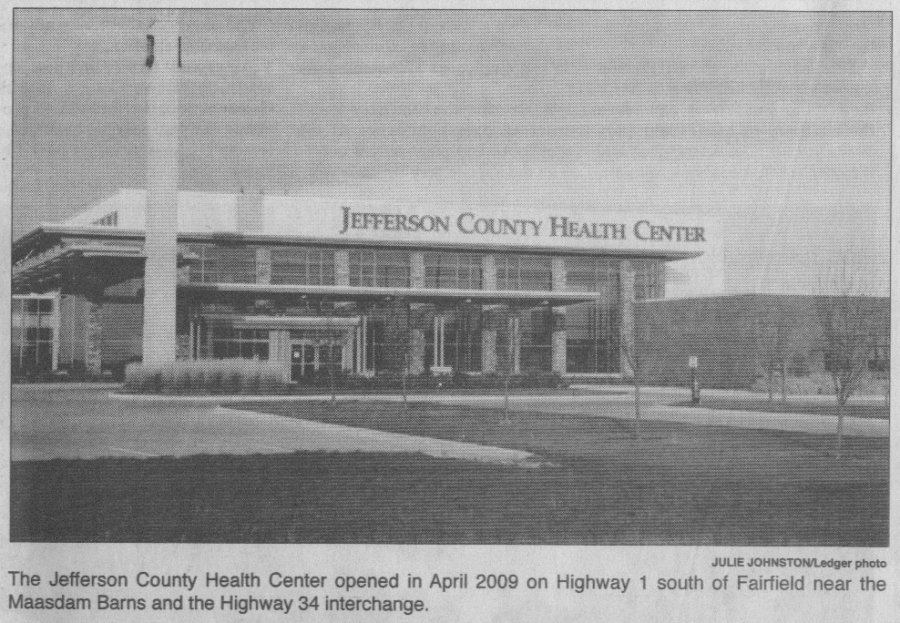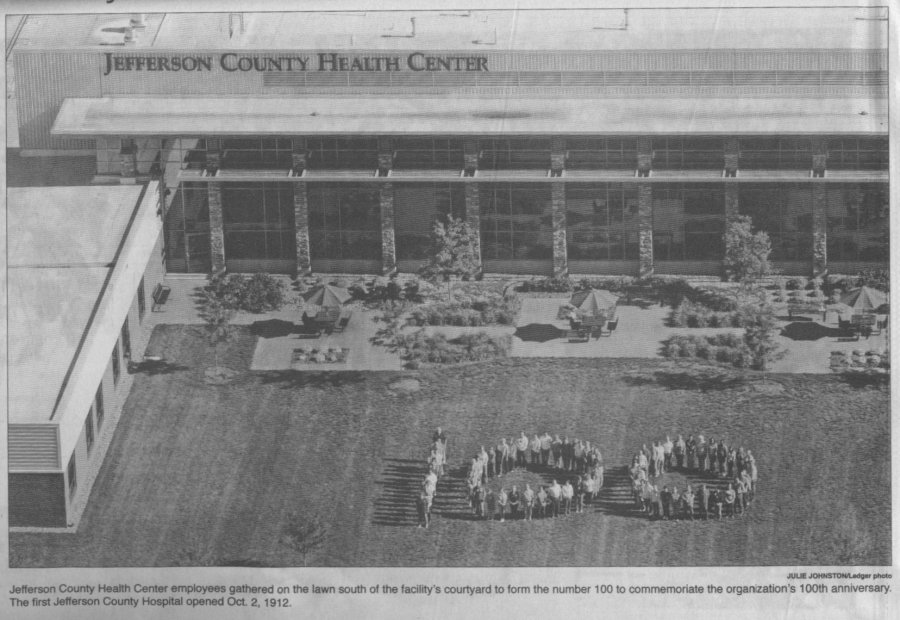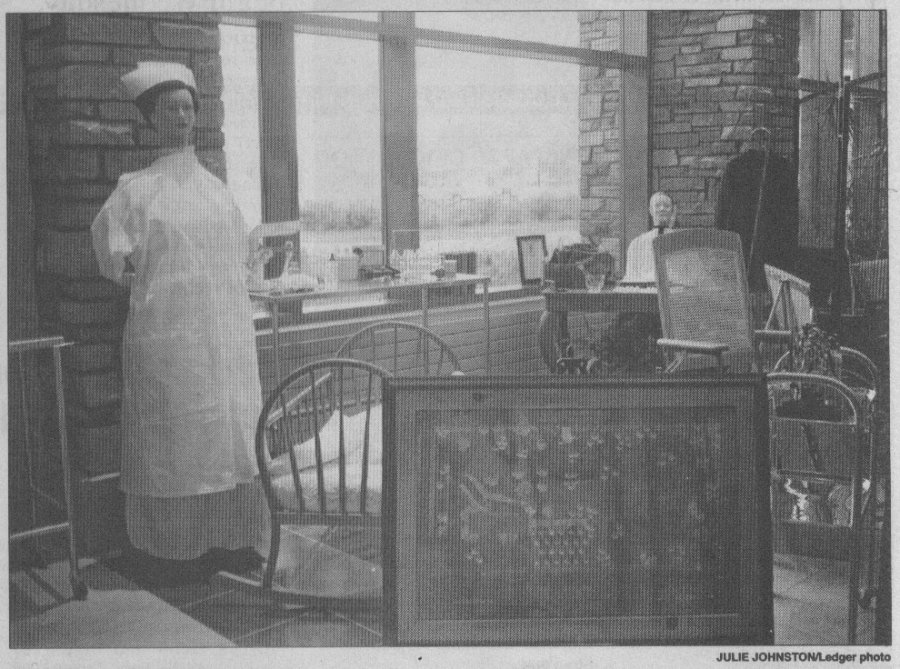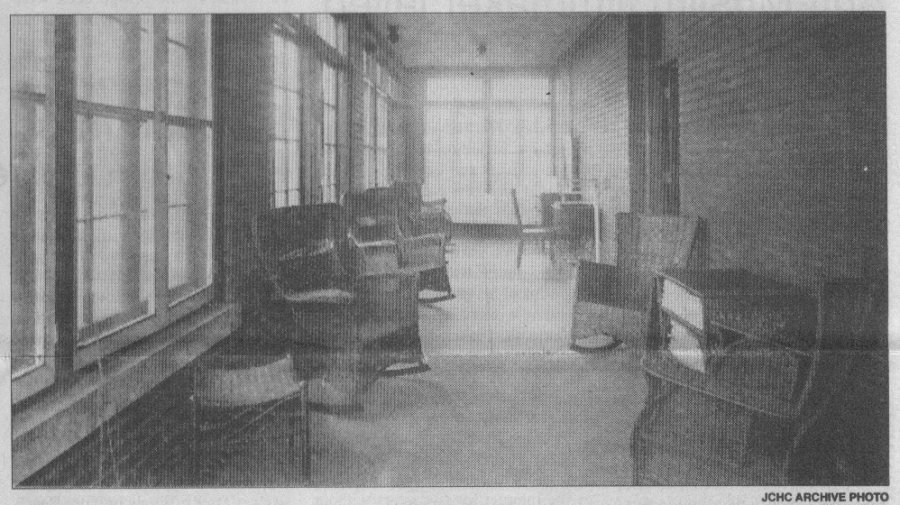 |
Jefferson County Health Center Celebrates 100 years in 2012 |
 |
 |
Jefferson County Health Center Celebrates 100 years in 2012 |
 |
"The Fairfield Ledger"
Tuesday, July 31, 2012
Pages 2A, 3A, and 8A
Jefferson County Health Center celebrates 100th anniversary
By Vicki Tillis
Ledger news editor
Jefferson County Health Center is reflecting on decades of change and looking toward the future as it celebrates its 100th anniversary this year.
The original $41,000 25-bed Jefferson County Hospital facility opened Oct. 2, 1912, on the site of the current SunnyBrook Living Care Center at the corner of Highland Street and Madison Avenue in the southeast part of town.
Now, known as Jefferson County Health Center -- a name reflecting the organization's commitment to total health care, explained administrator and CEO Deb Cardin and vice president of clinical services Joneane Parker -- the hospital moved into a new modern facility along Highway 1 south of Fairfield in April 2009.
When the hospital moved, it brought its history, along with pieces of community history, with it, said Cardin and Parker. For example, the plaques listing the names of donors from the old hospital now hang in the new facility, stained glass windows from Parsons College's Barhydt Chapel were incorporated into the health center's chapel and the stained glass window from the former Star Hardee's restaurant can be seen in a busy hallway.
The health center's history started with a $27,000 hospital bond issue carried in Jefferson County in 1911, heavily supported within the city and soundly turned down in the countryside where there was voter approval only in Cedar, Center and Brookville (sic - Locust Grove?) townships.
The success of the issue, coupled with private donations, is credited to Dr. J. Fred Clarke, who is said to have led the campaign, which made Fairfield a forerunner in the nation with its country hospital.
Stemming from new state legislation authorizing counties to build their own hospitals, it was the second time in history rural people taxed themselves for a hospital; Washington County, just north of Jefferson County, was the first by several months.
As its early reputation developed, the hospital received inquiries from throughout the country and Canada for information about this new country hospital plan, and it is reported the 886 farmers who had voted against the bond issue changed their minds and came to approve the hospital concept.
In 1913, hospital income was $1,170 short of meeting the $9,140 in operating costs. The difference was paid by county tax. In comparison, the health center ended fiscal year 2012 with total operating expenses of $24,441,818 and net income of $2,252,808.
Throughout the years, the hospital under went several remodeling projects totaling more than several million dollars.
The first of those projects came about because the patient load rose from 240 in 1913 to 1,346 in 1944. In November 1946, voters approved a $200,000 bond issue for an addition and repair to the original building. It was the first project in Iowa under a new federal law providing assistance to counties, towns or non-profit organizations for new hospitals or remodeling existing old ones.
The project, completed in 1949, cost $547,500 and added 20 beds.
The original 1912 hospital was razed in a 1970 building program. The building had to go in order to qualify for a federal grant of $480,000. It was part of a $1.5 million expansion plan of new and remodeled facilities, completed in 1971.
The hospital facility continued to change over the years as it strived to meet the health care needs of the community, and when the opportunity became available for the hospital to construct a new, updated facility built to fit its needs, it forged ahead.
The new facility includes many green principals and a layout that took privacy, patient care and convenience into consideration.
Parker said more people come to the health center today for outpatient procedures than to be admitted, so those areas -- the lab, the X-ray department, the physical therapy department and others -- were purposely placed closer to the main entrance, while the in-patient rooms, administration offices and housekeeping were placed further away.
The in-patient rooms, Parker continued, were designed to accommodate a patient, as well as his or her whole family unit.
"We wanted family friendly spaces," she said, explaining each patient room has a recliner and a window seat that will accomodate sleeping family members.
Parker added each private patient room has its own bathroom, with a wheel-in shower and fold-down bench; an overhead system to help staff safely lift patients in and out of bed purchased by the Jefferson County Health Center Auxiliary -- "I don't know where we'd be without the auxiliary ... They've done so much for the hospital over the years."; a sink just inside the door "because hand washing is so important"; and a view of the health center's court yard, pond or the neighboring Maasdam Barns.
"Connections to nature are important because they're healing," said Parker. "You won't see the institutional mint green, white or stainless steel here."
A big change in the inpatient wing is "pods" -- one pod for two rooms, which provides convenient access for things the patients need.
"Nurses aren't way down the hall at a nurses station any more; they're right outside the rooms," said Cardin.
She and Parker also pointed out the health center's communications system, another benefit from the auxiliary, sends a patient's page directly to his or her nurse, and the nurse can use the system to call dietary, pharmacy or other departments for things a patient needs.
Although the new facility is only three years old, it is already planning an expansion project.
Cardin said while room for growth was included in the health center's design, she never dreamed it would be full in three years.
"It's terrific we're growing and that we can provide services to the community, but we have no more room," she told the health center board of trustees in April. "Growth is a good thing, but we have to find space for everyone."
With the addition of the Southeast Iowa Neurological Associates and the American EyeCare Optometry services, the JCHC Professional Clinic is full, Cardin told the board.
The health center's specialty clinic area also is out of room.
"We host more than 50 specialty clinics a month," said Parker, and because there isn't enough space, some of those clinics are held in other areas of the health center, plus, the adjacent Medical Arts Clinic is out of space and has been using exam rooms in the specialty clinic area. Cardin said Medical Arts has doubled its physicians to 10 and is seeing new patients every week since its move to the health center three years ago.
Cardin added the health center also has been approached by a pharmacy that would like to have a presence on site. That contract should be signed this week.
And, with all the current and upcoming services being offered, the health center also is expanding its parking lot.
Chris Smith of Carl A. Nelson & Company, who oversaw the construction of the Jefferson County Health Center, also is overseeing the expansion project. In May, the trustees approved hiring HGA Architects and Engineers as the architectural firm, and the trustees also approved paying for the project in cash.
"We're thrilled to provide quality services that will keep people here," said Cardin.
"We're not a Band Aide hospital," said Parker, explaining the staff's goal is to treat patients locally, not to examine them and send them for treatment at a larger medical facility.
A new telemedicine program, which provides long distance evaluations, consultations and education, will help the local health center keep and treat more patients here.
The health center's goal is to provide access to care to as many people in as many ways possible, Cardin and Parker said.
Health center officials periodically meet with advocacy groups composed of representatives from all the county's demographics -- senior citizens, farmers, business leaders and others -- to learn what people in the community are saying about the facility and to listen to their suggestions on how services can be improved.
The health center also has a Championship Culture to encourage its employees to take ownership of workplace productivity and accountability. The health center has goals, but so do each employee and how those goals have been met is part of his or her yearly evaluation.
"So everyone is working toward the same thing," said Parker. "We try to be the very best for the communities that we serve."
For the organization's 100th anniversary, an event, with state-level government representatives invited, is being planned Oct. 2 at the Fairfield Arts & Convention Center. The details are still being arranged.
Parker said Joan Tedrow, who worked at Jefferson County Hospital for more than 41 years from September 1957 through Dec. 1, 1998 -- the last few years as director of nursing -- is compiling a commemorative book about the hospital.
"She's our main historian," said Parker.
Tedrow also is new member of the Jefferson County Health Center Board of Trustees. She was sworn in and welcomed during the board's meeting in January(.) She was appointed to complete the term of Grace Bogaards, who resigned in December. The term will end in 2014.
Also as part of the 100th anniversary, the health center and the auxiliary are compiling a commemorative cookbook.
"The ladies at the hospital thought this was a really nice thing to do for their 100th anniversary and asked the auxiliary to help," said Judy White, president of the auxiliary and member of the cookbook committee. "It's a history of our health center through recipes from employees, former employees and community members."
White said the auxiliary won't order an over abundance of the cookbooks and plans to sell out -- "Get them while they're hot."
The cookbooks will be ready for the Oct. 2 celebration.
With a new facility and new services, Jefferson County Health Center is looking forward to providing the best possible health care for the community in its next 100 years.
Hospital Facts from the Past
Below are photos that accompanied the story.




"The Fairfield Ledger"
Friday, September 28, 2012
Front Page and Page 9
Health center marks 100 years
Jefferson County Health Center rededication ceremony set Tuesday
by Vicki Tillis
Ledger news editor
Jefferson County Health Center is reflecting on decades of change and looking toward the future as it celebrates its 100th anniversary next week.
Health center officials are inviting the community to a rededication ceremony at 2 p.m. Tuesday.
The ceremony will take place under a big white tent -- the kind used for weddings, said the health center's community relations manager Ginny Hughes -- in the courtyard on the south side of the facility facing the Maasdam Barns.
"It's very pretty there," she added.
"Nan Cameron has gifted us with two programs from the original dedication in 1912, and we have tailored the dedication exactly as the original," said Joneane Parker, vice president of clinical services.
According to Parker, the original dedication had music by Schmidt's Orchestra, but for Tuesday's ceremony, Ron Prill, whose wife Betty was director of nurses for many years, and Dr. James Dunlevy have put together a band of local musicians to provide the music.
For the ceremony, Dr. Donal Hill will give the invocation; a congratulatory letter from Iowa Gov. Terry Branstad, who is in Washington, D.C., will be read; and Fairfield Mayor Ed Malloy will give a proclamation.
"Dr. Mike Greiner, chief of staff, will deliver an address as the original chief of staff did," said Parker.
Greiner's address, "The Role of the Hospital in the Prevention of Disease," will be followed by Rep. Curt Hanson's address "Hospitals in Rural Communities," and health center administrator and CEO Deb Cardin's state-of-the-hospital report comparing today to 100 years ago.
Bob Keller, chairman of the heath (sic) center's board of trustees, will present the hospital to the county, and on behalf of the county, supervisor Dick Reed will accept.
More music from the Dixieland Band and a reception will follow the ceremony.
"The public is welcome, and we are hoping for a good turnout," said Parker. "After all, we only have one chance to celebrate a 100th anniversary!"
While attending the ceremony, visitors also can stop in the health center's lobby to see a replica of a 1912 doctor's office and hospital room.
"The diorama is a collection of things from Jefferson County Health Center history and from some staff donors," said Parker, who set up the display. "The patient rooms actually had the washstands as depicted and a pitcher and basin. The wheelchair is also original to JCH."
Parker said many items in the display have special significance, such as a picture of the Rodenmayer girls, the first twins born at Jefferson County Hospital in 1913.
"Carol Messer, the daughter of one, supplied the information and picture, and we were able to locate the original OB log and corroborate the event," said Parker.
The diorama also includes a photo of Jefferson County Hospital School of Nursing's first graduating class in 1915. Joan Fulton of Nebraska, whose mother was one of the first graduates, sent the photo.
Oct. 2 is the date the original $41,000 25-bed Jefferson County Hospital opened in 1912 on the site of the current SunnyBrook Living Care Center at the corner of Highland Street and Madison Avenue in the southeast part of town.
Now, known as Jefferson County Health Center -- a name reflecting the organization's commitment to total health care, explained Cardin and Parker -- the hospital moved into a new modern facility along Highway 1 south of Fairfield in April 2009.
The health center's history started with a $27,000 hospital bond issue carried in Jefferson County in 1911, heavily supported within the city and soundly turned down in the countryside where there was voter approval only in Cedar, Center and Brookville (sic - Locust Grove?) townships.
The success of the issue, coupled with private donations, is credited to Dr. J. Frederic Clarke, who is said to have led the campaign, which made Fairfield a forerunner in the nation with its county hospital.
Stemming from new state legislation authorizing counties to build their own hospitals, it was the second time in history rural people taxed themselves for a hospital; Washington County was first by several months.
As its early reputation developed, the hospital received inquiries from throughout the country and Canada for information about this new county hospital plan, and it is reported the 886 farmers who had voted against the bond issue changed their minds and came to approve the hospital concept.
Throughout the years, the hospital under went several remodeling projects totaling more than several million dollars.
The first of those projects came about because the patient load rose from 240 in 1913 to 1,346 in 1944. In November 1946, voters approved a $200,000 bond issue for an addition and repair to the original building. It was the first project in Iowa under a new federal law providing assistance to counties, towns or nonprofit organizations for new hospitals or remodeling existing ones.
The project, completed in 1949, cost $547,500 and added 20 beds.
The original 1912 hospital was razed in a 1970 building program. The building had to go in order to qualify for a federal grant of $480,000. It was part of a $1.5 million expansion plan of new and remodeled facilities, completed in 1971.
The hospital facility continued to change throughout the years as it strived to meet the health care needs of the community, and when the opportunity became available for the hospital to construct a new, updated facility built to fit those needs, it forged ahead.
Although the new facility is only three years old, it is already started an expansion project. (sic)
Cardin said while room for growth was included in the health center's design, she never dreamed it would be full in three years.
Chris Smith of Carl A. Nelson & Company, who oversaw the construction of the Jefferson County Health Center, also is overseeing the expansion project on the north side of the facility. The new space will provide additional room for the Medical Arts Clinic, outpatient clinics, the new NuCara Pharmacy and more.
Also as part of the 100th anniversary, the health center and the auxiliary published a commemorative cookbook with 588 recipes from employees, former employees and community members.
"The ladies at the hospital thought this was a really nice thing to do for their 100th anniversary and asked the auxiliary to help," said Judy White, president of the auxiliary and member of the cookbook committee. "It's a history of our health center through recipes from employees, former employees and community members."
White said the auxiliary didn't order an over abundance of the cookbooks and plans to sell out -- "Get them while they're hot."
The $15 cookbooks will be available at the celebration Tuesday and in the health center's gift shop.
Parker said health center trustee Joan Tedrow, who worked at Jefferson County Health Center for more than 41 years from September 1957 through Dec. 1, 1998 -- the last few years as director of nursing -- is compiling a commemorative book about the hospital.
"The commemorative book is being printed and will be available later this fall," said Parker. "It will be purchasable."
With a new facility, Jefferson County Health Center is looking forward to providing the best possible health care for the community in the next 100 years.
Below are photos that accompanied the story.


"The Fairfield Ledger"
Wednesday, October 3, 2012
Front Page and Page 7
Jefferson County Health Center observes 100 years
By Vicki Tillis
Ledger news editor
A standing-room-only crowd beneath a large white tent in the courtyard helped the Jefferson County Health Center celebrate its 100th anniversary at 2 p.m. Tuesday.
The event organized by Joneane Parker, vice president of clinical services, was a recreation of the dedication ceremony of the original Jefferson County Hospital in 1912.
The original ceremony included music by the Schmidt's Orchestra, while the ceremony Tuesday included music by Dixieland Band. The band included former longtime Fairfield Clinic PC physician Dr. James Dunlevy, who traveled from Minnesota to play trombone; and Ron Prill, whose late wife, Betty, was director of nursing for many years at the hospital, also played trombone and led the group.
Dr. Donal Hill, a physician at Medical Arts Clinic, gave the invocation, followed by administrator and CEO Deb Cardin reading a letter from Iowa Gov. Terry Branstad. Branstad was unable to attend the ceremony as he was in Washington, D.C.
Fairfield Mayor Ed Malloy proclaimed Oct. 2, 2012, as a day of celebration for the 100th year of Jefferson County Health Center and presented a plaque to Cardin. Malloy said the celebration was a way to thank the facility and its staff for the care provided to community members.
Dr. Michael Greiner, a Medical Arts Clinic physician and chief of Jefferson County Health Center medical staff, gave the address "The Role of the Hospital in the Prevention of Disease."
Greiner pointed out although the title was the same as for the address given during the 1912 dedication ceremony, the original text has been lost. He reviewed the progress of health care during the last 100 years, pointing out 1912, like 2012, was an election year, and Grover Cleveland was proposing a national health care plan. "It's still an issue," said Greiner.
According to Greiner, $5 was the average a person spent on health care in 1912, and the top reasons for death were pneumonia, flu, tuberculosis, diarrhea, heart disease and stroke. He said 100 years ago, when a person developed an infection, the hope was his or her body would heal itself. Since then, great strides have been made, including the discovery and use of antibiotics, anesthesia, CT scans that allow doctors to see into a body and treat a body as never before, and much more.
Now, Greiner continued, Jefferson County Health Center continues to respond to calls for change and is planning for the future.
Greiner asked if the people who had the vision to build the original hospital 100 years ago would be proud of what it has become, and said, "I believe the answer is a resounding yes."
Rep. Curt Hanson of House District 90 spoke about the health care center's history. He said Fairfield's native son J. Frederic Clarke dreamed of a hospital in Fairfield. To achieve that dream, Clarke ran for and was elected to the Iowa House of Representatives in 1906, where he teamed up with E. E. Munger of Spencer on a bill that would allow counties to levy a tax to build a hospital.
The bill was passed in 1909, in 1911, Jefferson County voters approved a $27,000 bond issue. It was the second time in history rural people taxed themselves for a hospital; Wahsington County, Iowa, was the first by several months.
Hanson said rural hospitals began as a controversial issue, but have grown into a million dollar industry that Iowans rely on for the majority of their health care and into an important component for the economic health of Iowa.
Cardin reported on the status of the health care center. She compared the hospital's Dec. 31, 1913, report to the health care center's most recent yearly report.
The old hospital had 25 beds, as does the current health care center. The old hospital had 296 patients admitted, with a daily patient average of 9.4, and an average length of stay of 13 days. The health center had 1,040 patients admitted, with a daily patient average of 14, and an average length of stay of 5.5 days.
Cardin said 181 surgeries were performed in 1912 at the old hospital, compared to 1,396 last year at the health center. She also pointed out the hospital's 11 employees has grown to 209.
The hospital superintendent Amy Beers's report also stated the hospital earnings from Jan. 1, 1913, through Jan. 1, 1914, were $7,970.13. Cardin said earnings from July 1, 2011, though June 30, 2012, were $25,283,689.
Cardin also read from hospital board president E. D. Y. Culbertson's report written in early 1913. The report stated: "All taxpayers wonder whether a special ... tax pays. That this hospital pays there can be not doubt. There are people whose lives have been spared for further usefulness by the fact that this hospital was in reach at the time needed. There are infants whose vitality was too low to have upheld the spark of life except by the care and equipment offered at the hospital. There are old people who have found the ministering to their ailments given at the hospital satisfying and comforting as their cycles of years were closing. These are values in return for our taxes that money does not measure." Cardin said, "I sincerely believe these words hold true today, and I trust the present public also realize the immeasurable value Jefferson County Health Center adds to this community and the people we serve."
Every building has a story," said Jefferson County Health Center Board of Trustees Chairman Bob Keller. "This is definitely a different building, but the same community hospital dedicated to caring for the people we serve."
Keller rededicated the Jefferson County Health Center and presented it to area residents and the county, represented by Jefferson County Supervisor Dick Reed.
"Can you imagine what we'll look like in 100 years?" asked Reed. "One hundred years ago, there was a horse-drawn ambulance sitting out front ... This is your hospital, the one you voted for ... use it, trust it."
Below is a photo that accompanied the story.

Jefferson County Health Center's 106-year Story Wall, installed in 2018.